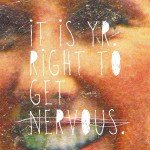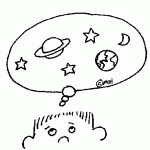SMPC Day 2: Session 2 (Imagery and earworms)
 The afternoon of Day 2 was to feature a session on earworms and imagery, where I was to give my talk on ‘Coping with earworms’. This would be the first public presentation of my group’s data on how people deal with the tunes that get stuck in their head, so I was nervous and anxious to see if a) anyone was interested and b) what people thought of the research.
The afternoon of Day 2 was to feature a session on earworms and imagery, where I was to give my talk on ‘Coping with earworms’. This would be the first public presentation of my group’s data on how people deal with the tunes that get stuck in their head, so I was nervous and anxious to see if a) anyone was interested and b) what people thought of the research.
First however, I had the pleasure of sitting in on the presentation of my good friend Georgina Floridou (Goldsmiths, University of London) who was presenting her PhD work on the relationship between earworms and mind wandering.
Georgina has a strong passion for ecologically valid research which I admire; she is always asking me ‘but how does that work in the real world?’ or ‘how can we do this research outside the lab?’ It is great to have someone like this in your life as they make sure you keep one eye on the true implications of your experimental findings.

It therefore came as no surprise to me when she started working on a large Experience Sampling Method (ESM) paradigm to assess experiences of earworms. ESM uses prompts (usually by text) to collect data in real time and at random across weeks. Georgina probed how people experienced earworms, how this related to mind wandering, and how both experiences were influenced by factors such as mood, concurrent activities, and pleasantness of the earworm.
Georgina used Bayesian modelling approaches to analyse her data. These networks allow implementation of difference testing between factors and also plot hierarchical relationships between them. In effect, they can tell you not only if two factors are related to each other but in which direction the influence lies.
 She has found that time of day and concurrent activities are interrelated variables that influence the experience of earworms and then, the presence of earworms influences mind wandering. Finally, this pathway draws together to influence mood. In another model the circumstances surrounding the triggering of earworms influenced the rated pleasantness of the experience.
She has found that time of day and concurrent activities are interrelated variables that influence the experience of earworms and then, the presence of earworms influences mind wandering. Finally, this pathway draws together to influence mood. In another model the circumstances surrounding the triggering of earworms influenced the rated pleasantness of the experience.
Overall, her data provides real time and real world insights into the relationships between earworms and mind wandering states; their connections, generation and consequences in our daily lives.
The next talk was a very well designed study by Rachel Brown (McGill, Canada) on the influences of imagery ability on both the encoding stages and retrieval stages of a music memory task. I apologise to Rachel in that I did not take in too much from her talk as I was starting to get nervous about my own presentation at that point!
 What I did gather is that she was seeking to discover how auditory and motor interference influenced accuracy in a pitch memory task, when it was placed either at the time of learning or subsequent recall. Rachel also pre-assessed people for general imagery ability and looked at the relationships between this and the influence of interference.
What I did gather is that she was seeking to discover how auditory and motor interference influenced accuracy in a pitch memory task, when it was placed either at the time of learning or subsequent recall. Rachel also pre-assessed people for general imagery ability and looked at the relationships between this and the influence of interference.
She found that people who were good at imagery were better at learning in general and during the presence of interference. There were also effects of imagery ability on subsequent recall. As a result of these findings Rachel argues that a superior imagery ability makes people less vulnerable to interference from both sounds and other motor sources; the key now would be to work out why.
 Finally it was my turn. As usual I feel very nervous just up to the point of presenting and then the ‘act’ comes on; a person that looks and sounds a lot like me but is much more confident in front of a crowd. I have built the ‘act’ over the last 8 years of presenting research but, believe me, it is just practice. Inside there is the real me and she is always very nervous!
Finally it was my turn. As usual I feel very nervous just up to the point of presenting and then the ‘act’ comes on; a person that looks and sounds a lot like me but is much more confident in front of a crowd. I have built the ‘act’ over the last 8 years of presenting research but, believe me, it is just practice. Inside there is the real me and she is always very nervous!
My research is the first descriptive study of how people cope with earworms. In the past both survey and diary studies on earworms have asked people how they deal with an unwanted earworm experience and whether or not these methods work, but crucially they have only ever presented limited tick box options.
I was convinced that these methods were missing out on a huge variety of earworm coping techniques that people had tried and tested over their life; techniques that could not only inform out knowledge of how to cope with unwanted earworms but that might also hold clues to the nature of the experience itself, where it comes from and why these tunes get so stuck.
So I looked at the responses of 831 people who had written to our research group to describe their earworm coping stories. The analysis of so many stories takes a lot of time, and my collaborator Kelly Jakubowski (Goldsmiths, University of London) and I spent many hours coding these stories to extract common themes that describe the underlying techniques. We also looked at the relationships between them and grouped them in a parsimonious visual model.
The final model, by sheer size, demonstrates the true variety of earworm control strategies that are out there in the world (thanks to liskovoi for this photo of my talk!). People do all kinds of things, but underlying their methods are several interesting convergent clues to earworms and their control.
1) Cure tunes; tunes that people say knock out earworms and then don’t themselves get stuck. Is there something inherent in these tunes , in their structure, that may help people who want to control their earworms? Further analysis will tell…
2) Distraction; when trying to distract from an earworm people more often than not use verbal and musical strategies, not visual, spatial or physical. Is this bias telling us something about how earworms are generated in memory? Ongoing work in our lab will hopefully reveal more…
3) Engagement; people often seek out the tunes that are stuck in their head, playing them over and over again all the way to the end to expunge the sound. Is this compulsion driven by an aspect of the earworm tune that can cause it to repeat? The unfinished element that must be completed, the so called ‘Zeigarnik effect’? Again, time will tell…
 I had a lovely reception even though I was a few minutes over time (shame on me). I had great questions including my favourite; ‘Could we not look at the positives of earworms and their potential uses, for example in learning, rather than just trying to expunge them?’
I had a lovely reception even though I was a few minutes over time (shame on me). I had great questions including my favourite; ‘Could we not look at the positives of earworms and their potential uses, for example in learning, rather than just trying to expunge them?’
‘Yes’ I said ‘Absolutely we can’. Control is an important issue for those people who are annoyed or distressed by their earworms, but there are absolutely important clues in the earworm experience that we can harness to better understand musical memory and learn how we may best use it to help us with our everyday memory challenges.
One Comment
Pingback: